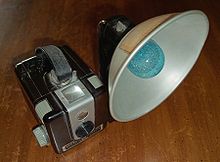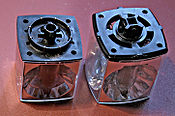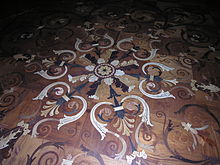- Flash (photography)
-
 The furious wing action of a Hummingbird Hawk-moth is frozen by flash. The flash has given the foreground more illumination than the background. See Inverse-square law
The furious wing action of a Hummingbird Hawk-moth is frozen by flash. The flash has given the foreground more illumination than the background. See Inverse-square law
A flash is a device used in photography producing a flash of artificial light (typically 1/1000 to 1/200 of a second) at a color temperature of about 5500 K to help illuminate a scene. A major purpose of a flash is to illuminate a dark scene. Other uses are capturing quickly moving objects or changing the quality of light. Flash refers either to the flash of light itself or to the electronic flash unit discharging the light. Most current flash units are electronic, having evolved from single-use flashbulbs and flammable powders. Modern cameras often activate flash units automatically.
Flash units are commonly built directly into a camera. Some cameras allow separate flash units to be mounted via a standardized "accessory mount" bracket (hot shoe). In professional studio equipment, flashes may be large, standalone units, or studio strobes, powered by special battery packs or connected to mains power. They are either synchronized with the camera using a flash synchronization cable or radio signal, or are light-triggered, meaning that only one flash unit needs to be synchronized with the camera, and in turn triggers the other units.
Contents
Types of flashes
Flashbulbs
The earliest flashes had of a quantity of flash powder consisting of a mechanical mixture of magnesium powder and potassium chlorate that was ignited by hand. Later, magnesium filaments were contained in flash bulbs filled with oxygen gas, and electrically ignited by a contact in the camera shutter; such a bulb could only be used once, and was too hot to handle immediately after use, but the confinement of what would otherwise have amounted to a small explosion was an important advance. An innovation was coating flashbulbs with a blue plastic coating to match the spectral quality to daylight balanced colour film and to make it look more moderate, as well as providing shielding for the bulb in the unlikely event of it shattering during the flash. Later bulbs substituted zirconium for the magnesium, which produced a brighter flash and tended to temporarily blind people.
Flashbulbs took longer to reach full brightness and burned for longer than electronic flashes. Slower shutter speeds (typically from 1/10 to 1/50 of a second) were used on cameras to ensure proper synchronization. Some shutters triggered the flashbulb a fraction of a second prior to opening, permitting use of faster shutter speeds. A widely used flashbulb through the 1960s was the number 25. This is the large (approximately 1 inch (25 mm) in diameter) flashbulb often shown used by newspapermen in period movies, usually attached to a press camera or a twin-lens reflex camera.
Flashcubes, Magicubes and Flipflash
In the late 1960s, Kodak improved their Instamatic camera line by replacing the individual flashbulb technology (used on early Instamatics) with the Flashcube. Flashcubes consisted of four electrically fired flashbulbs with an integral reflector in a cube-shaped arrangement that allowed taking four images in a row. A mechanism in the camera automatically rotated the flashcube 90 degrees to a fresh bulb upon advancing the film to the next exposure.
The later Magicube (or X-Cube) retained the four-bulb format, and was superficially similar to the original Flashcube. However, the Magicube did not require electrical power- each bulb was set off by a plastic pin in the cube mount that released a cocked spring wire within the cube. This wire, in turn, struck a primer tube, at the base of the bulb, which contained a fulminate. The fulminate ignited shredded Zirconium foil in the flash and, thus, a battery was not required. Magicubes could also be fired by inserting a thin object, such as a key or paper clip, into one of the slots in the bottom of the cube.
Flashcubes and Magicubes are superficially similar but not interchangeable. Cameras requiring flashcubes have a round socket and a round hole for the flashcube's pin, while those requiring Magicubes have a round shape with protruding studs and a square socket hole for the Magicube's square pin. The Magicube socket can also be seen as an X, which accounts for its alternate name, X-Cube.
Another common flashbulb-based device was the Flipflash which included ten or so bulbs in a single unit. The name derived from the fact that once half the flashes had been used up, the unit had to be flipped and re-inserted to use the remainder.
Modern flash technology
Today[update]'s flash units often incorporate electronic flashtubes, and are sometimes called speedlights or (erroneously) strobes. An electronic flash contains a tube filled with xenon gas, where electricity of high voltage is discharged to generate an electrical arc that emits a short flash of light. (A typical duration of the light impulse is 1/1000 second.) As of 2003, the majority of cameras targeted for consumer use have an electronic flash unit built in.
Another type of flash unit are microflashes, which are high-voltage flash units discharging a flash of light with an exceptionally quick, sub-microsecond duration. These are commonly used by scientists or engineers for examining extremely fast moving objects or reactions, famous for producing images of bullets tearing through objects like lightbulbs or balloons (see Harold Eugene Edgerton).
Studio flashes usually contain a modeling light, an incandescent lightbulb close to the flash tube. The continuous illumination of a modeling light helps in visualizing the effect of the flash.
The strength of a flash device is often indicated in terms of a guide number, despite the fact that the published guide numbers of different units can not necessarily be directly compared. The strength of larger studio flash units, such as monolights are indicated in watt-seconds.
Flash intensity
Unlike flashbulbs, the intensity of an electronic flash can be adjusted on some units. Small flash units typically vary the length of time of the discharge, larger (studio) units typically charge the capacitor less. The disadvantage of charging the capacitor less is that the color temperature may change, necessitating corrections. With advances in semiconductor technology, there are some monolight (studio) units which can vary the time of the discharge.[1]
The flash duration is typically described with two numbers: t.5 is the length of time for which the flash impulse is above 0.5 (50%) of the peak intensity, while t.1 is the length of time for which the impulse is above 0.1 (10%) of the peak[2] (t.3 of course, would be above 30%). For instance, t.5 can be 1/1200 sec whereas t.1 can be 1/450 sec for the same flash at the same intensity. For a small flash controlling intensity by time, the t.5 and t.1 numbers decrease as the intensity decreases. On flash units controlling intensity by capacitor charge, the t.5 and t.1 numbers increase as the intensity decreases (i.e. takes longer for the capacitor to discharge to that point). These times become important if a person wants to freeze action with the flash (as in sports).
Flash intensity is typically measured in stops or in fractions (1, 1/2, 1/4, 1/8 etc.). Some monolights display an "EU Number", so that a photographer can know the difference in brightness between different flash units with different watt-second ratings. EU10.0 is defined as 6400 Watt-seconds, and EU9.0 is one stop lower, i.e. 3200 watt-seconds.[3]
Flash LED illumination
Although they are not yet at the power levels to replace xenon flash devices in still cameras, high-current flash LEDs have recently been used as flash sources in camera phones. The major advantages of LEDs over xenon include low voltage operation, higher efficiency, and extreme miniaturization.
Focal-plane-shutter synchronization
Electronic flash units have compatibility issues with focal-plane shutters. Focal-plane shutters expose using two curtains that cross the sensor. The first one opens and the second curtain follows it after a delay equal to the nominal shutter speed. A typical modern focal-plane shutter takes about 1/200s to cross the sensor, so at exposure times shorter than this only part of the sensor is uncovered at any one time. Electronic flash can have durations as short as 50 µs, so at such short exposure times only part of the sensor is exposed. This limits the shutter speed to about 1/200s when using flash. In the past, slow-burning single-use flash bulbs allowed the use of focal-plane shutters at maximum speed because they produced continuous light for the time taken for the exposing slit to cross the film gate. If these are found they cannot be used on modern cameras because the bulb must be fired *before* the first shutter curtain begins to move (M-sync); the X-sync used for electronic flash normally fires only when the first shutter curtain reaches the end of its travel.
High-end flash units address this problem by offering a mode, typically called FP sync or HSS (High Speed Sync), which fires the flash tube multiple times during the time the slit traverses the sensor. Such units require communication with the camera and are thus dedicated to a particular camera make. The multiple flashes result in a significant decrease in guide number, since each is only a part of the total flash power, but it's all that illuminates any particular part of the sensor. In general, if s is the shutter speed, and t is the shutter traverse time, the guide number reduces by √s / t. For example, if the guide number is 100, and the shutter traverse time is 5 ms (a shutter speed of 1/200s), and the shutter speed is set to 1/2000s (0.5 ms), the guide number reduces by a factor of √0.5 / 5, or about 3.16, so the resultant guide number at this speed would be about 32.
Current (2010) flash units frequently have much lower guide numbers in HSS mode than in normal modes, even at speeds below the shutter traverse time. For example, the Mecablitz 58 AF-1 digital flash unit has a guide number of 58 in normal operation, but only 20 in HSS mode, even at low speeds.
Technique
As well as dedicated studio use, flash may be used as the main light source where ambient light is inadequate, or as a supplementary source in more complex lighting situations. Basic flash lighting produces a hard, frontal light unless modified in some way.[4] Umbrellas and softboxes are commonly used for this purpose (even with small hand-held flash units).
Fill flash or "fill-in flash" describes flash used to supplement ambient light in order to illuminate a subject close to the camera that would otherwise be in shade relative to the rest of the scene. The flash unit is set to expose the subject correctly at a given aperture, while shutter speed is calculated to correctly expose for the background or ambient light at that aperture setting.
Bounce flash is a related technique in which flash is directed onto a reflective surface, for example a white ceiling or a flash umbrella, which then reflects light onto the subject. It can be used as fill-flash or, if used indoors, as ambient lighting for the whole scene. Bouncing creates softer, less artificial-looking illumination than direct flash, often reducing overall contrast and expanding shadow and highlight detail, and typically requires more flash power than direct lighting.[4]
Part of the bounced light can be also aimed directly on the subject by "bounce cards" attached to the flash unit which increase the efficiency of the flash and illuminate shadows cast by light coming from the ceiling. It's also possible to use one's own palm for that purpose, resulting in warmer tones on the picture, as well as eliminating the need to carry additional accessories.
Also, slave flash units exist that are set up away from the subject and camera, that are triggered by the light from the master flash. This slave flash provides fill or bounce light. Many small flashes and studio monolights have optical slaves built in. Wireless radio transmitters, such as PocketWizards are also popular for remote synchronization since the receiver unit can be around a corner, or well over 100 meters away (which would be far too difficult to trigger using an optical sync).
Another method that can be used is strobe. Some high end units can be set to flash a specified number of times at a specified frequency. This allows action to be frozen multiple times in a single exposure.[5]
Colored gels can also be used to change the color of the flash. Correction gels are commonly used, so that the light of the flash would be the same as the tungsten lights (using a CTO gel) or the fluorescent lights.
Drawbacks
- Using on-camera flash will give a very harsh light, which results in a loss of shadows in the image, because the only lightsource is in practically the same place as the camera. Balancing the flash power and ambient lighting or using off-camera flash can help overcome these issues. Using an umbrella or softbox (the flash will have to be off-camera for this) makes softer shadows.
- A typical problem with cameras using built-in flash units is the low intensity of the flash; the level of light produced will often not suffice for good pictures at distances of over 3 meters (10 ft) or so. Dark, murky pictures with excessive image noise or "grain" will result. In order to get good flash pictures with simple cameras, it is important not to exceed the recommended distance for flash pictures. Larger flashes, especially studio units and monoblocks, have sufficient power for larger distances, even through an umbrella, and can even be used against sunlight, at short distances.
- The "Red-eye effect" is another problem with on camera and ring flash units. Since the retina of the human eye reflects red light straight back in the direction it came from, pictures taken from straight in front of a face often exhibit this effect. It can be somewhat reduced by using the "red eye reduction" found on many cameras (a pre-flash that makes the subject's irises contract). However, very good results can be obtained only with a flash unit that is separated from the camera, sufficiently far from the optical axis, or by using bounce flash, where the flash head is angled to bounce light off a wall, ceiling or reflector.
- On some cameras the flash exposure measuring logic fires a pre-flash very quickly before the real flash. In some camera/people combinations this will lead to shut eyes in every picture taken. The blink response time seems to be around 1/10 of a second. If the exposure flash is fired at approximately this interval after the TTL measuring flash, people will be squinting or have their eyes shut. One solution may be the FEL (flash exposure lock) offered on some more expensive cameras, which allows the photographer to fire the measuring flash at some earlier time, long (many seconds) before taking the real picture. Unfortunately many camera manufacturers do not make the TTL pre-flash interval configurable.
- Flash distracts people, limiting the number of pictures that can be taken without irritating them.
- Photographing with flash may not be permitted in some museums even after purchasing a permit for taking pictures.
- Flash equipment may take some time to setup, and like any grip equipment, may need to be carefully secured, especially if hanging overhead so it does not fall on anyone. A small breeze can easily topple a flash with an umbrella on a lightstand if it is not tied down or sandbagged. Larger equipment (e.g. monoblocks) will need a supply of A.C. power.
See also
- BC Flash
- Guide number
- Flash synchronization
- Inverse-square law
- List of photographic equipment makers
- Ring flash
- Flash Comparison
- Flash-lamp
- Through-the-lens metering
References
- ^ http://www.paulcbuff.com/pcb2009/flashduration.html
- ^ http://www.sportsshooter.com/news/1888
- ^ http://74.208.158.244/files/manuals/pdf/e640_0310.pdf
- ^ a b Langford, Michael (7th ed. 2000). Basic Photography. Focal Press/Butterworth Heinemann. pp. 117. ISBN 9780240515922. http://books.google.com/books?id=mj60n3uH4eMC&pg=PA198&dq=flash+lighting#v=onepage&q=flash%20lighting&f=false.
- ^ http://qswags.blogspot.com/2010/06/strobe-tips.html
External links
- Flash Photography Article
- Flash Photography with Canon EOS Cameras
- Minolta Flash Compendium
- Strobist - The Small-Flash Photography Blog
- Tutorials on Tangents website
- Photographic Cheat SheetPDF (87.2 KB)
- Flashbulb Types
- Flash Comparison Chart
- Information on Flashbulbs from a manufacturer
- Camera Flashes Reviews
Categories:- Flash photography
- Photographic lighting
- Light sources
Wikimedia Foundation. 2010.










